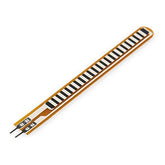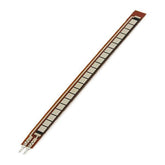Flex Sensor Functionality and Applications
Summary
Flex sensors are devices that convert physical bending or flexing into electrical signals. They are used in a variety of applications, from measuring the movement of limbs to monitoring the stress on bridges.
There are two main types of flex sensors: resistive and capacitive. Each has its own strengths and weaknesses, and the choice between them depends on the specific application.
Understanding the different types of flex sensors is crucial for choosing the right sensor for your project.
What is a Flex Sensor?
A flex sensor calculates the degree of bending or deflection. It is a pressure-sensitive resistive sensor that notices when an object's shape changes as a result of coming into touch with another object.
In common usage, the Flex sensor is stuck on the surface of the object and measures the amount of bending which is proportional to the change in resistance of the sensor.
The most popular design for flex sensors combines thin metal sheets with resistive material strips. Plastic and carbon can be used in the design of this sensor. The resistance of the sensor changes whenever the resistive material is twisted.
It can also be used as a goniometer because the amount of rotations directly affects the resistance's variation.
Types of Flex Sensors
Flex Sensors are available in two sizes, 2.2 inches & 4.5 inches. They are also divided based on their resistances, High resistance, Medium resistance and Low Resistance Flex Sensor.
Although their resistance and sizes vary, the basic function still remains the same. We need to choose the appropriate sensor based on our requirements.
This type of sensor is used in various applications such as computer interfaces, rehabilitation, servo motor control, security system, music interface, intensity control and wherever the consumer needs to adjust the resistance during bending.

Fiber Optic Flex Sensor:
As the name suggests, this sensor is made of Optic Fiber, and is used in the measurement of acceleration, displacement, and mechanical stress.
The device works on the principle of transmitting light from a superluminescent source through optic fiber.
Consequently, its parameters like fibre brag grating (change of refractive index of the fiber along the line) will change which will help us in measuring the change.
Velostat Flex Sensor:
It is made up of the piezoresistive plastic film. The sensor is between two layers of neoprene, so it doesn't really react to bends, instead, it exerts pressure, and the resistance is measured in terms of pressure.
Conductive Ink-Based Flex Sensor:
It is the most commonly used type of flex sensor. It reacts to the change in shape and changes the resistance proportional to the change in shape.
This unipolar sensor changes the resistance when you bend it in one direction, but if you bend it in the opposite direction it doesn’t change the resistance and it could also get damaged.
Capacitive Flex Sensor:
It has two layers of capacitor plates. The first surface is combined with an insulating surface and the second layer has another capacitor plate with a flexible substrate.
Pin Configuration
Flex Sensors have 2 terminals but unlike diodes or capacitors they are not polarized hence there are no positive or negative terminals. But pin P1 is generally connected to the power supply (+ve), and pin P2 is connected to the ground (GND/-ve).
This sensor requires 3.3 to 5V DC.
Working Principle:
This sensor device works on the principle of bending strips, which means whenever the strip is bent, its resistance is changed, which can be measured with the help of a controller. Other in other, this sensor works like a variable resistance whose resistance is changed when it is bent.
Sensors resistance increases with a change in its linearity.
-
Flatline gives nominal resistance

- Line or Sensor bent at an angle of 45° gives double resistance

- Line or sensor bent at 90° gives 4 times the nominal resistance

Specifications and features
- Voltage ratings range from 0 V to 5V
- Operating temperatures range from -45 C to 80 C
- power ratings range from 0.5 W to 1 W (peak)
- Resistor tolerance is 30%.
- Resistor tolerance is 30%.
- 25K is the flat resistance.
- The resistance tolerance will be 30%.
- The bend resistance range will be 45 K to 125 K Ohm.
Application:
The Flex sensor has many applications like most sensors. Although it is widely used as a goniometer in rehabilitation research, its applications can be seen in various fields such as human-machine interfaces, geology, and musical instruments.
In each application, the sensor identifies the bend in terms of variable resistance that can be digitally recorded, and the data is then used differently depending on the application.
With the advent of goniometer gloves, the measurement of joint movements in rehabilitation research, which was previously measured by mechanical goniometers, has become easier. Nowadays these gloves are used as Human Machine interfaces (HMI).
Another type of HMI input device called shape tape was created to replicate the shapes of real objects into the CAD environment. In geology, the sensor was used to identify landslides from a distance.
Flex Sensors can also be used for creating musical instruments that can be played by bending the instrument and creating amusing musical effects.
In addition to these existing applications, this paper proposes another application to use the sensor to identify dents in sheet metal panels by recording the bending in two dimensions through the sheet metal.
This sensor is used wherever you need to test the outer surface of the device, otherwise, the thing is planned or not. A flex sensor can be used to check whether a door or window is open or not.
This sensor can be placed on the edge of the door and once the door is opened, this sensor will also bend. When the sensor bends, its parameters change automatically, which can be designed to issue an alert.
The internal resistance of this sensor varies approximately linearly with its bending angle. Therefore, by connecting the sensor to the device, we can have a bending angle within the resistances of the electrical parameter.
Some of its popular applications are:
- Gaming (Virtual Motion, like finger movement using a glove)
- Robotics
- Medical Devices
- Physical Therapy
- Angular Displacement Measurement
- Motion Control Devices
- Automotive
- Musical Devices
Conclusion
flex sensors are versatile and adaptable components that play a crucial role in various industries, from robotics to medical devices. By understanding the types of flex sensors available and their applications, you can make an informed decision on which sensor best suits your needs.
Whether you're a hobbyist, a professional engineer, or simply curious about the latest technology, flex sensors offer an exciting world of possibilities. So go ahead, flex your creativity, and explore the endless potential of flex sensors!
If you appreciate our work don't forget to share this post and leave your opinion in the comment box.
Please do check out other blog posts about Popular electronics
Make sure you check out our wide range of products and collections (we offer some exciting deals!)






